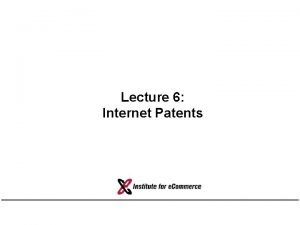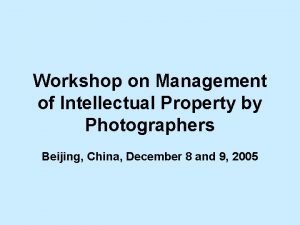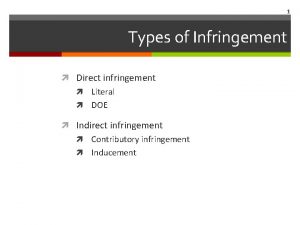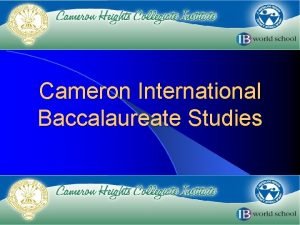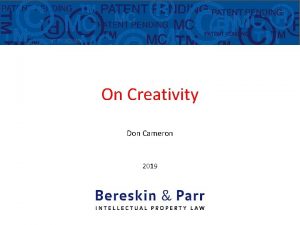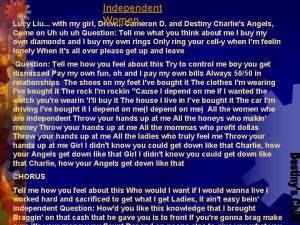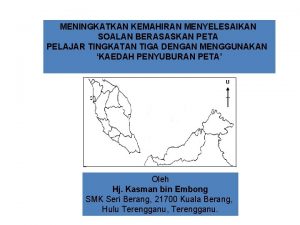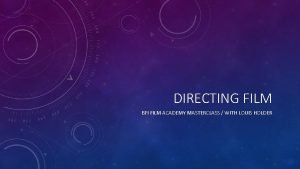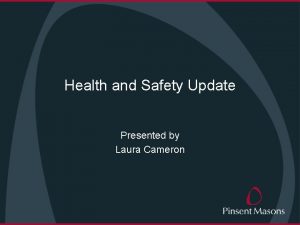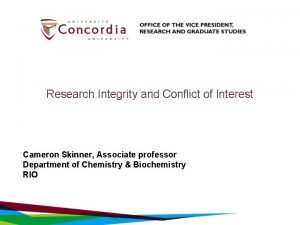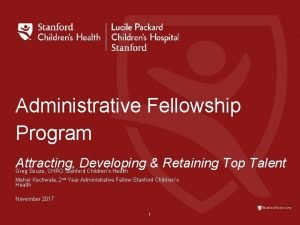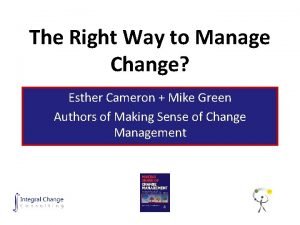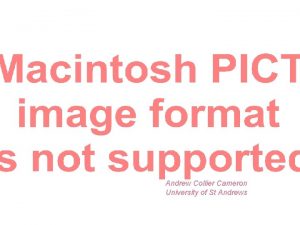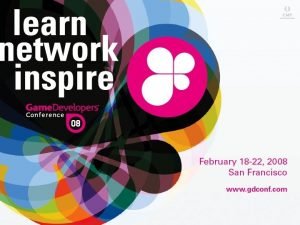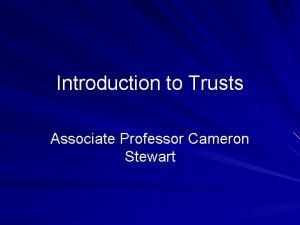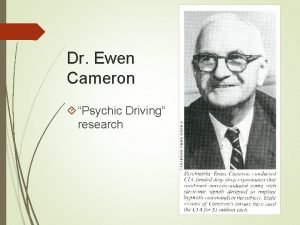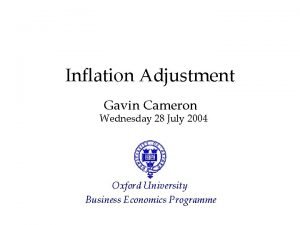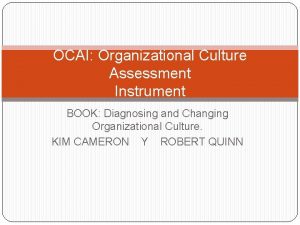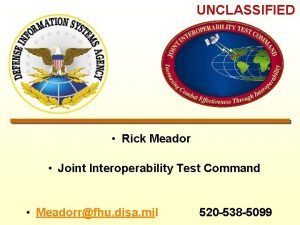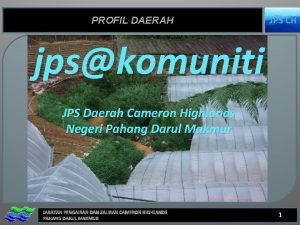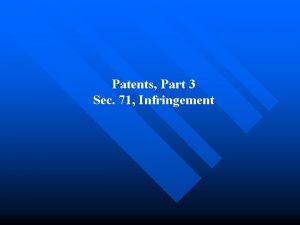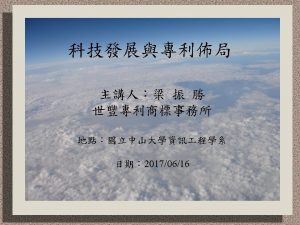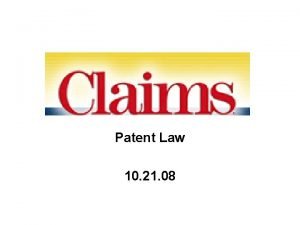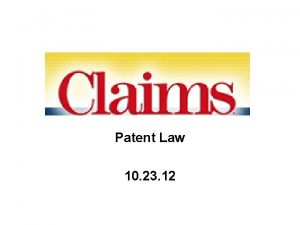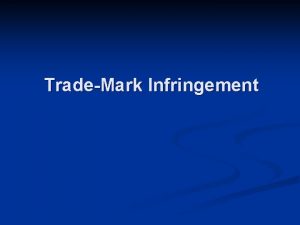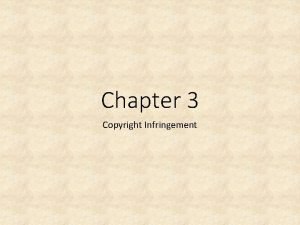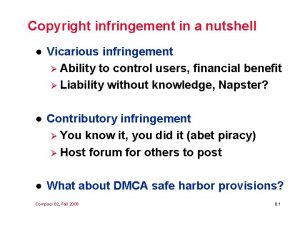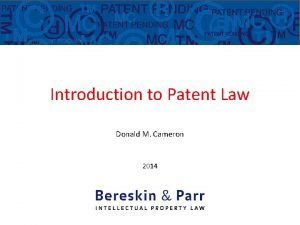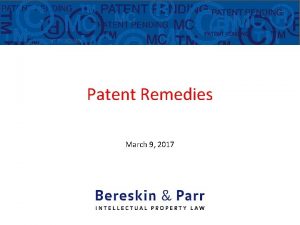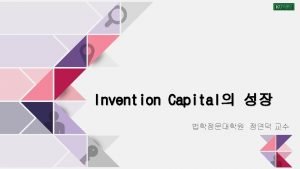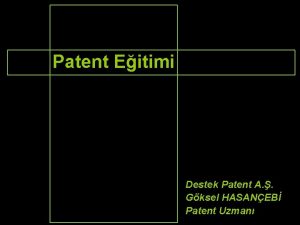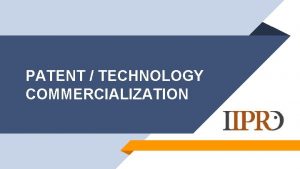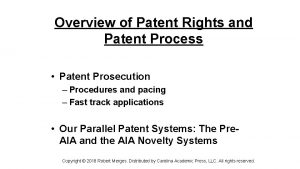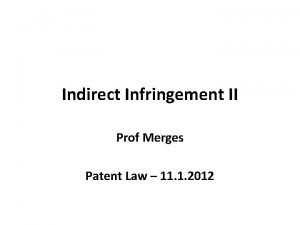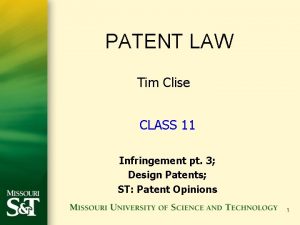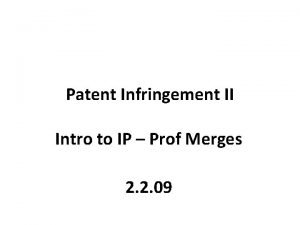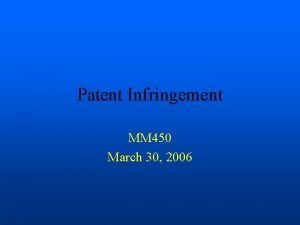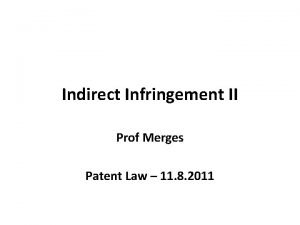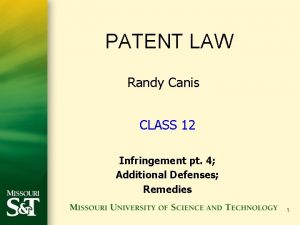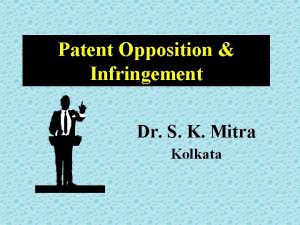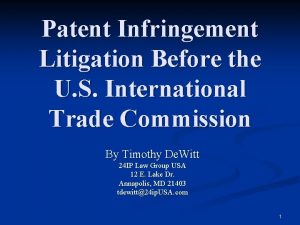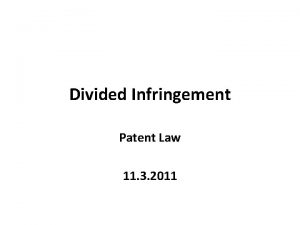Patent Infringement Donald M Cameron 2018 Donald M
































- Slides: 32

Patent Infringement Donald M. Cameron 2018 Donald M. Cameron

What is infringement? • “any act that interferes with the full enjoyment of the monopoly granted to the patentee” • s. 42: “… the exclusive right, privilege and liberty of making, constructing and using the invention and selling it to others to be used …” 2

Have the essential elements of the claim been taken/used? • What do the words and phrases in the claim mean? • Are the essential ones there? • Purposive construction: – Sometimes read down the claim – Whirlpool: “vanes” meant “rigid vanes” and did not include “flexible vanes” 3

CANADA Imagine an 8 slice pizza (or a claim with 8 elements) 1. Construe the claims: Determine what are the essential elements 4

CANADA 2. If there are 6 essential elements, have all 6 been taken? If so, there’s infringement. (Don’t worry about the non -essential elements – they don’t matter) 5 NONESSENTIAL

What’s an essential element? 1. It’s essential if changing it changes the way the invention works. 2. It’s essential if the inventor meant it to be essential.

Recap – claim construction the set up • Who: – Person (or team) of ordinary skill in the art to whom the patent is directed • What – The claim terms “where the shoe pinches” • When – At the date of publication (for patent applications filed after October 1989) 7

Recap • Read the patent as a whole, and construe the claims in the context of the patent. • If the disclosure expressly defines certain terms to have certain meanings, use those definitions when interpreting the claims. • The relevant date for construing the patent claims is either: – The date of issuance of the patent, for patents applied for before October 1, 1989; or – the date of publication of the patent application, for patents applied for on or after October 1, 1989 • Read the patent as if you were the person to whom it was addressed. Except for terms expressly defined in the patent, give the terms in the claim the ordinary meaning they would have had to such person as of the relevant date. 8

Apply the “principles” from Free World “Adhere to the language” (Invention limited to what has been claimed) (a) The Patent Act promotes adherence to the language of the claims. (b) Adherence to the language of the claims in turn promotes both fairness and predictability. (d) The language of the claims thus construed defines the monopoly. There is no recourse to such vague notions as the “spirit of the invention” to expand it further. Essential & Non-Essential (e) The claims language will, on a purposive construction, show that some elements of the claimed invention are essential while others are non-essential. The identification of elements as essential or non-essential is made: (iii) having regard to whether or not it was obvious to the skilled reader at the time the patent was published that a variant of a particular element would not make a difference to the way in which the invention works; or (iv) according to the intent of the inventor, expressed or inferred from the claims, that a particular element is essential irrespective of its practical effect; 9

To apply Free World • Think “Cameron”: • To determine whether a claim element is essential or not, ask: – Was it obvious to the skilled reader at the time the patent was published that a variant of a particular element would not make a difference to the way in which the invention works? If modifying or omitting the element changes the way the invention works, and that was obvious at the relevant date, then the element is essential; or – According to the intent of the inventor, expressed or inferred from the claims, was a particular element essential irrespective of its practical effect? If the element appears to have been intended to be essential, then the element is essential. • If the claim element was not found to be essential under either Q 1 or Q 2, then the element is non-essential. 10

But use Improver 1. Does the variant have a material effect upon the way the invention works? If yes, then the variant is outside the claim. If no? 2. Would this (i. e. that the variant had no material effect) have been obvious at the date of publication of the patent to a reader of the patent skilled in the art? If no, the variant is outside the claim. If yes? 3. Would the reader skilled in the art nevertheless have understood from the language of the claim that the patentee intended that strict compliance with the primary meaning was an essential requirement of the invention? If yes, then the variant is outside the claim. (In other words, is the patentee using the term in a special way, different from the “normal” meaning? ) 11

Windsurfing v. Trilantic 12

Windsurfing v. Trilantic 1. Wind-propelled apparatus comprising body means adapted to support a user and windpropulsion means pivotally associated with said body means and adapted to receive wind for motive power for said apparatus, said propulsion means comprising a mast, a joint for mounting said mast on said body means, a sail and means for extending said sail laterally from said mast, the position of said propulsion means being controllable by said user, said propulsion means being substantially free from pivotal restraint in the absence of said user, said joint having a plurality of axes of rotation whereby said sail free falls along any of a plurality of vertical planes upon release by said user. 4. The apparatus of Claim 1 wherein said sail extending means comprises a boom laterally disposed of said mast to hold sail taut and adapted to provide a hand-hold for said user. 10. The apparatus of Claim 4, wherein said boom comprises a pair of boom members arcuately connected athwart said mast and securing said sail therebetween. 13

Does Darby Infringe? 14

Does Darby Infringe? 15

Territorial limits to patents • Infringement in Canada: – Made used or sold… in Canada Domco • Infringement in USA – Method claims must be practised in USA (no inf) – System infringes if control and benefit is in USA • NTP v. RIM 16

17

Who sues who? • Plaintiff(s) – Patentee (must be a party) and legal representative – And all persons claiming under the patentee • Includes licensees • May include customers • Defendants – Makers, users, sellers – Directors or officers 18

Making and constructing • Making just parts is OK • Making part when you’re licensed to make all isn’t OK • Making something for patented use outside Canada isn’t OK • Repairing is OK; rebuilding is not 19

Presumptions • S. 55. 1: New process to make a new product, presumption is that the product was made by the patented process 20

Using • “utilize with a view to production or advantage” • (commercial benefit belongs to the patentee) • Possession creates presumption of intended use • Schmeiser used the gene or cell; he could have sprayed (“stand-by” use, like a fire extinguisher) • Use of a product of a patented process (whether or not product is patented) 21

Selling • Must be in Canada • Anywhere along the chain is infringing 22

Importation • For what purpose? – Resale – actionable – Research – not actionable – Transhipment – who knows? • Importation of a product made offshore by a patented process is infringement – Onus of proof on defendant to show foreign supplier does not use the patented process – May apply to product made abroad by infringing product. 23

Importation cont’d • Saccharin doctrine – Where the patented product is an intermediate used to make the imported product, and it’s of some importance and not merely incidental, importation is an infringement 24

Inducing and Procuring Infringement • “She made me do it” • Person who knowingly, for his/her own ends and benefits, induces or procures infringement • Stop the instigator – too hard to go after all the infringers • Vendor of kits 25

“Indirect infringement” – what’s needed 1. “direct” infringement (threatened or happened) 2. Defendant caused the direct infringer to do “it” 3. Defendant knew such influence would result in the infringing actions 26

Common Design (divided infringement) 1. Was there was a common design between the parties to do acts which, if the patent is upheld, amounted to infringement; and 2. Did the defendant act in furtherance of that design. • Unilever Plc v. Gillette (UK) Limited, [1989] R. P. C. 583 at 608 -609. 27

Defences/Exceptions to Infringement • Gillette defence: Hobson’s choice – If claims broad – include prior art & invalid – If claims narrow – no infringement • Experimental use – To improve – To test – s. 55. 2: for regulatory approval • Prior acquired goods (s. 56) – Prior to the claim date 28

US Approach Doctrine of Equivalents • An equivalent has the same: – Function – Way – Result • [See also Actavis v. Eli Lilly in UK where protection > claim scope]

USA 30 CANADA

USA CANADA EQUIVALENT • • 31 All elements test: are all elements or their equivalents present? Each element can be expanded by doctrine of equivalents: performs the same function in the same way to achieve the same result

USA CANADA EQUIVALENT NONESSENTIAL • All elements • Each element can be expanded by doctrine of equivalents 32 • All essential elements • No D. O. E.
 Infringement of patent
Infringement of patent Nancy kwai
Nancy kwai Intellectual property in professional practices
Intellectual property in professional practices Literal infringement
Literal infringement Que letra continua m v t m j
Que letra continua m v t m j Cameron boag
Cameron boag Cameron heights ib program
Cameron heights ib program Safavid empire
Safavid empire Cameron herran
Cameron herran Lucy lui with my girl drew
Lucy lui with my girl drew Rejlander
Rejlander Cameron highland tanah runtuh
Cameron highland tanah runtuh James cameron masterclass
James cameron masterclass R v lion steel ltd 2012
R v lion steel ltd 2012 Cameron skinner
Cameron skinner Caitlin crooks
Caitlin crooks Cameron hall uncc
Cameron hall uncc Esther cameron
Esther cameron Cameron house st andrews
Cameron house st andrews Cameron egbert
Cameron egbert Dr betsy schwartz
Dr betsy schwartz Defintion of trust
Defintion of trust Cameron mott
Cameron mott Dr ewen cameron
Dr ewen cameron Gavin cameron
Gavin cameron Instrumento ocai de cameron y quinn
Instrumento ocai de cameron y quinn Cameron meador
Cameron meador K means dimensionality reduction
K means dimensionality reduction Jps wilayah
Jps wilayah Forensic science learning targets
Forensic science learning targets Leanne cameron
Leanne cameron Merzenich et al (1984) ib psychology
Merzenich et al (1984) ib psychology Rita moreno biografia
Rita moreno biografia
